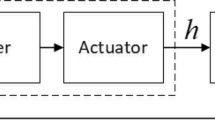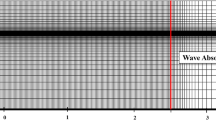Abstract
The analysis and understanding of the complex behaviour of a ship propulsion plant are of great importance for novel system design, control system synthesis/optimization and to sustain the safety of ship operation in harsh sea conditions. The convenient way to evaluate the design and propulsion performance of a ship in waves is by simulation combining the experimentally obtained characteristics of hull and propeller with the dynamic model of the prime mover. However, the propeller and engine compose a strongly coupled system, in which fluctuating inflow velocity into the propeller due to the wave and hull motions causes propeller torque and rotating speed fluctuations. The latter affects the response of the propulsion engine and vice versa; however, considering the propulsion system response in waves by a full-scale test is hardly possible. Thus, in the past, the authors have developed the experimental methodology of the self-propelled ship model test in which an intelligent propeller drive is controlled by a Marine Diesel Engine Simulator (MDES) providing the response of the engine model in real time, based on the measured propeller torque and speed. This paper introduces further development of MDES in which a full-state dynamic cycle-mean value engine model was introduced providing deep insight into propulsion engine responses in a real-like condition of the actual sea. The similarity of the engine responses at the ship model scale is ensured by the original method of equations transformation developed by the authors. The newly developed MDES was introduced into the self-propulsion model, and a test series in regular waves was performed. The obtained responses were compared with the results of numerical simulation of the full-scale model confirming the validity of the new development and the importance of intrinsic engine characteristics on propulsion system response in waves.







Similar content being viewed by others
Abbreviations
- \(\tilde{A}_{{\text{o}}}\) :
-
Average area [m2]
- \(B\) :
-
Hull breadth [m]
- \(C_{{{\text{p}}{\text{.e}}}}\) :
-
Specific heat of exhaust gas \(\left[ {{\text{J}}\,{\text{kg}}^{{ - 1}} \;{\text{K}}^{{ - 1}} } \right]\)
- \(C_{{{\text{p}}{\text{.a}}}}\) :
-
Specific heat of air \(\left[ {{\text{J}}\,{\text{kg}}^{{ - 1}} \;{\text{K}}^{{ - 1}} } \right]\)
- \(d_{{\text{m}}}\) :
-
Hull draft [m]
- \(D_{{\text{p}}}\) :
-
Propeller diameter [m]
- \(E_{{\text{f}}}\) :
-
Low Calorific Value of fuel \(\left[ {{\text{J}}\;{\text{kg}}^{{ - 1}} } \right]\)
- \(G_{{\text{a}}}\) :
-
Air mass flow through engine \(\left[ {{\text{kg}}\;{\text{s}}^{{ - 1}} } \right]\)
- \(G_{{\text{c}}}\) :
-
Air mass flow through compressor \(\left[ {{\text{kg}}\;{\text{s}}^{{ - 1}} } \right]\)
- \(G_{{\text{e}}}\) :
-
Exhaust gas mass flow through turbine \(\left[ {{\text{kg}}\;{\text{s}}^{{ - 1}} } \right]\)
- \(G_{{\text{f}}}\) :
-
Fuel mass flow \(\left[ {{\text{kg}}\;{\text{s}}^{{ - 1}} } \right]\)
- \(g\) :
-
Gravitation acceleration constants \(\left[ {{\text{m}}\;{\text{s}}^{{ - 2}} } \right]\)
- \(h_{{\text{p}}}\) :
-
Fuel pump rack index [–]
- \(H_{{\text{c}}}\) :
-
Energy rate of gas out of the cylinder \(\left[ {{\text{J}}\;{\text{s}}^{{ - 1}} } \right]\)
- \(H_{{\text{e}}}\) :
-
Energy rate of gas before the turbine \(\left[ {{\text{J}}\;{\text{s}}^{{ - 1}} } \right]\)
- \(I_{{{\text{sh}}}}\) :
-
Inertia of whole shaft line \(\left[ {{\text{m}}\;{\text{s}}^{{ - 2}} {\text{kg}}} \right]\)
- \(I_{{{\text{tc}}}}\) :
-
Inertia of turbocharger shaft \(\left[ {{\text{m}}\;{\text{s}}^{{ - 2}} {\text{kg}}} \right]\)
- \(J\) :
-
Propeller advance ratio [–]
- \(K_{{\text{t}}} ,K_{{\text{q}}}\) :
-
Propeller open water coefficients [–]
- \(k_{{\text{e}}}\) :
-
Exhaust gas specific heat ratio [–]
- \(L\) :
-
Hull length [m]
- \(m\) :
-
Weight of ship hull [kg]
- \(m_{{\text{x}}}\) :
-
Added weight of ship hull [kg]
- \(M_{{\text{e}}}\) :
-
Mass of exhaust gas in the receiver [kg]
- \(m_{{{\text{f}}{\text{.c}}}}\) :
-
Fuel mass per cycle [kg]
- \({\text{mcr}}\) :
-
Maximum continuous rating [–]
- \(n_{{\text{e}}}\) :
-
Engine rotational speed \(\left[ {{\text{s}}^{{ - 1}} } \right]\)
- \(n_{{\text{p}}}\) :
-
Propeller rotational speed \(\left[ {{\text{s}}^{{ - 1}} } \right]\)
- \(n_{{{\text{tc}}}}\) :
-
Turbocharger rotational speed \(\left[ {{\text{s}}^{{ - 1}} } \right]\)
- \(P_{{\text{b}}}\) :
-
Brake mean effective pressure (BMEP) [Pa]
- \(P_{{\text{i}}}\) :
-
Mean indicating pressure (IMEP) [Pa]
- \(P_{{\text{f}}}\) :
-
Mean friction pressure (FMEP) [Pa]
- \(P_{{\text{a}}}\) :
-
Ambient air pressure [Pa]
- \(P_{{\text{e}}}\) :
-
Exhaust gas receiver pressure [Pa]
- \(P_{{\text{s}}}\) :
-
Scavenging air receiver pressure [Pa]
- \(Q_{{\text{e}}}\) :
-
Engine torque [Nm]
- \(Q_{{\text{p}}}\) :
-
Propeller torque [Nm]
- \(Q_{{\text{C}}}\) :
-
Torque of compressor [Nm]
- \(Q_{{\text{T}}}\) :
-
Torque of turbine [Nm]
- \(R_{{\text{a}}}\) :
-
Air gas constant \(\left[ {{\text{J}}\,{\text{kg}}^{{ - 1}} \;{\text{K}}^{{ - 1}} } \right]\)
- \(R_{{\text{e}}}\) :
-
Exhaust gas constant \(\left[ {{\text{J}}\,{\text{kg}}^{{ - 1}} \;{\text{K}}^{{ - 1}} } \right]\)
- \(R_{{\text{t}}}\) :
-
Calm water resistance of hull [N]
- \(T_{{\text{a}}}\) :
-
Ambient air temperature [K]
- \(T_{{\text{e}}}\) :
-
Exhaust gas temperature (before turbine) [K]
- \(T_{{\text{s}}}\) :
-
Scavenging air temperature [K]
- \(t_{{\text{p}}}\) :
-
Thrust deduction factor [–]
- \(u_{{\text{p}}}\) :
-
Propeller inflow velocity \(\left[ {{\text{m}}\;{\text{s}}^{{ - 1}} } \right]\)
- \(u_{{\text{s}}}\) :
-
Hull longitudinal velocity \(\left[ {{\text{m}}\;{\text{s}}^{{ - 1}} } \right]\)
- \(V_{{\text{s}}}\) :
-
Swept volume of cylinder [m3]
- \(V_{{{\text{e}}{\text{.r}}}}\) :
-
Exhaust gas manifold volume [m3]
- \(V_{{{\text{s}}{\text{.r}}}}\) :
-
Scavenging receiver volume [m3]
- \(X_{{\text{p}}}\) :
-
Propeller thrust [N]
- \(X_{{\text{w}}}\) :
-
Resistance due to waves [N]
- \(w_{{\text{p}}}\) :
-
Wake fraction [–]
- \(W_{{\left( {{\text{a,b,c}}} \right)}}\) :
-
Static maps regression coefficients [–]
- \(Z_{{\text{c}}}\) :
-
Number of engine cylinders [–]
- \(\eta _{{\text{c}}}\) :
-
Relative combustion efficiency [–]
- \(\tau _{{\text{e}}}\) :
-
Time constant of engine [s]
- \(\tau _{{{\text{tc}}}}\) :
-
Time constant of turbocharger [s]
- \(\tau _{{{\text{s}}{\text{.r}}}}\) :
-
Time constant of scavenging receiver [s]
- \(\tau _{{{\text{e}}{\text{.r}}}}\) :
-
Time constant of exhaust receiver [s]
- \(\tau _{{\text{t}}}\) :
-
Time constant of exhaust temperature [s]
- \(\rho\) :
-
Density of water \(\left[ {{\text{kg}}\;{\text{m}}^{{ - 3}} } \right]\)
- \(\lambda\) :
-
Wave length \(\left[ {\text{m}} \right]\)
References
Communique of 72nd session of the IMO Marine Environment Protection Committee (MEPC)
Sutulo S, Guedes Soares C (2016) Analysis of manoeuvrability criteria and standards in view of environmental factors and EEDI impact. In: Proceedings of the 3rd International conference on maritime technology and engineering (MARTECH)
Nakamura S, Naito S (1975) Propulsive performance of a container ship in waves. J Kansai Soc Nav Archit Jpn 158
Naito S, Nakamura S, Hara S (1979) On the prediction of speed loss of a ship in waves. J Soc Nav Archit Jpn 146:147–156
Kim SK, Naito S, Nakamura S (1985) Propulsive performance of lower speed ship in seaway. J Kansai Soc Nav Archit Jpn 196:113–126
Schulten PJM (2005) The interaction between diesel engines, ship and propellers during manoeuvring. Delft University Press, Delft
Prpic-Orsic J, Faltinsen OM, Mrakovcic T (2013) Influence of ship behavior in seaway on CO2 emissions. In: Proceedings of the 32nd international conference on ocean, offshore and arctic (OMAE2013)
Taskar B, Yum KK, Pedersen E, Steen S (2015) Dynamics of a marine propulsion system with a diesel engine and a propeller subject to waves. In: Proceedings of the 34th international conference on ocean, offshore and arctic (OMAE2015)
Woodward JB, Lattore RG (1984) Modeling of diesel engine transient behavior in marine propulsion analysis. SNAME Trans 92:33–49
Theotokatos G (2008) Ship propulsion plant transient response investigation using a mean value engine model. Int J Energy 2(4):66–74
Bondarenko O, Kashiwagi M (2010) Dynamic behavior of ship propulsion plant in actual sea. J Jpn Inst Mar Eng 45:76–80
Tanizawa K, Kitagawa Y, Takimoto T, Tsukada Y (2013) Development of an experimental methodology for self-propulsion test with a marine diesel engine simulator. Int J Offshore Polar Eng 23:197–204
Kitagawa Y, Tanizawa K, Tsukada Y (2015) Development of an experimental methodology for self-propulsion test with a marine diesel engine simulator, the fourth report: direct measurement of actual ship speed in waves by model tests. In: Proceedings of the 25th international ocean and polar engineering conference, vol 3, pp 38–45
Huijgens LJG, Vrijdag A, Hopman JJ (2018) Propeller-engine interaction in a dynamic model scale environment. In: Proceedings of the 28th international ocean and polar engineering conference (ISOPE)
Bondarenko O, Fukuda T et al (2013) Development of diesel engine simulator for use with self-propulsion model. J Jpn Inst Mar Eng 48:98–105
Bondarenko O, Fukuda T (2020) Development of a diesel engine’s digital twin for predicting propulsion system dynamics. Energy 196:117126
Kitagawa Y, Bondarenko O et al (2019) An experimental method to identify a component of wave orbital motion in propeller effective inflow velocity and its effects on load fluctuations of a ship main engines in waves. Appl Ocean Res 92:101922
Kitagawa Y, Bondarenko O et al (2018) An application of the tank test with a model ship for design of ship propulsion system. J Jpn Inst Mar Eng 53:82–88
Nakamura S, Naito S, Inoue R (1975) Open-water characteristics and load fluctuations of a propeller in waves. J Kansai Soc Nav Archit Jpn 159:41–55 (in Japanese)
Ueno M, Tsukada Y, Tanizawa K (2013) Estimation and prediction of effective inflow velocity to propeller in waves. J Mar Sci Technol 18:339–348
Tsujimoto M et al (2016) Actual navigation simulator VESTA. In: Proceedings of national maritime research institute, vol 15, pp 449–459 (in Japanese)
Kitagawa Y, Kashiwagi M (2019) A strip method including nx-related terms and its effects on propeller inflow velocity in waves. J Jpn Soc Nav Archit 29:39–50
Baldi F, Theotokatos G, Andersson K (2015) Development of a combined mean value–zero dimensional model and application for a large marine four-stroke diesel engine simulation. Appl Energy 154:402–415
Acknowledgements
The authors wish to express sincere gratitude to Mr. Yoshiaki Tsukada at the National Maritime Research Institute for his considerable help during tank model tests, and to Mr. Tetsugo Fukuda at the National Maritime Research Institute for his considerable support and helpful discussions.
Author information
Authors and Affiliations
Corresponding author
Additional information
Publisher's Note
Springer Nature remains neutral with regard to jurisdictional claims in published maps and institutional affiliations.
About this article
Cite this article
Bondarenko, O., Kitagawa, Y. Development of detailed engine model for evaluation ship performance in waves by a self-propulsion model test. J Mar Sci Technol 27, 266–277 (2022). https://doi.org/10.1007/s00773-021-00832-y
Received:
Accepted:
Published:
Issue Date:
DOI: https://doi.org/10.1007/s00773-021-00832-y




